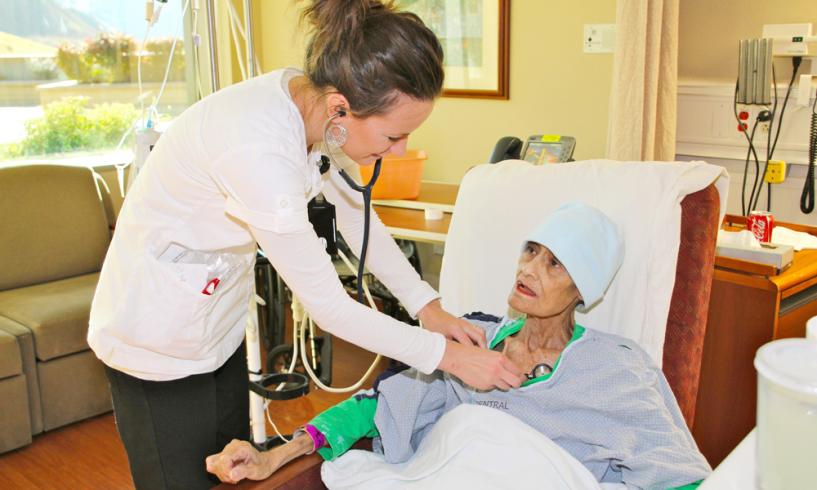Symptoms of lung cancer rarely occur in isolation. Rather, most patients experience a range of symptoms, from fatigue to cough, dyspnea, anorexia, pain, and insomnia. Although these groups of symptoms, or symptom clusters, have been studied in the past, research to date has not focused on the symptom experience of women with advanced lung cancer specifically.
In their article in the November 2011 issue of the Oncology Nursing Forum, Brown, Cooley, Chernecky, and Sarna reported the results of a prospective, correlational study of the symptom experience of 196 women with non-small cell lung cancer (NSCLC) at multiple treatment sites across the United States. A five-symptom cluster and a sentinel symptom were identified, and the implications of these findings were discussed.
Background
Previous studies of symptoms in patients with lung cancer have demonstrated a wide range of symptom experiences: fatigue, cough, dyspnea, anorexia, pain, emotional distress, nausea, vomiting, hair loss, dysphagia, and sore throat. Although few have looked at these symptoms in terms of clusters, some studies have identified symptom clusters ranging from two to seven symptoms. Most studies have focused on patients with advanced disease who were currently receiving treatment or palliative care. Patients with lung cancer generally have higher symptom distress, which is associated with shorter survival, than patients with other types of cancer. In particular, women with cancer report that fatigue, frequent pain, insomnia, and poor outlook are the most prevalent and distressing symptoms.
Symptom Clusters
In the current study, the women were six months to five years from diagnosis of NSCLC; 12% had recurrent disease and 13% were currently receiving treatment. The researchers looked at the prevalence of symptoms reported by the women in two timeframes: the past day and the past four weeks. Almost all (98%) of the women experienced three or more symptoms in the past day, and 64% reported the following five-symptom cluster. Of those experiencing the five-symptom cluster, 75% also had minimal blood in the sputum, but this was not included in the cluster.
- Fatigue
- Shortness of breath
- Anorexia
- Cough
- Pain
See Figure 1 for the list of symptoms by stage of disease. No predominant symptom cluster was identified for the past four weeks; however, 50% of the women experienced three or more co-occurring symptoms during that time period.

Related Factors
The researchers identified several factors that seemed to increase the severity of women’s symptoms and therefore the likelihood of developing a symptom cluster.
- Depressed mood
- Time since diagnosis
- Currently receiving treatment
- Number of comorbid diseases
- Age
- Meaning of illness to the patient
However, after controlling for each variable, the researchers found that only time since diagnosis was significantly related to the development of the symptom cluster. As time since diagnosis increased, the occurrence of the cluster decreased.
Sentinel Symptoms
The presence or absence of the five-symptom cluster was correlated with so-called sentinel symptoms, including pain, cough, loss of appetite, shortness of breath, and fatigue. Of those, pain was most highly correlated with the cluster. The researchers suggested that healthcare providers use the presence of pain as an indicator to further assess women for the other symptoms in the cluster.
Implications for Nurses
Brown et al. explained that their study findings demonstrated that fatigue and shortness of breath continue over time for women with NSCLC, even after treatment ends, and that they can co-exist with other symptoms as part of a symptom cluster. Healthcare providers should provide ongoing follow-up and management of long-term symptoms to ensure optimal quality of life for patients and survivors. For more information on symptom clusters and sentinel symptoms in women with NSCLC, refer to the full article by Brown et al. Five-Minute In-Service is a monthly feature that offers readers a concise recap of full-length articles published in the Clinical Journal of Oncology Nursing or Oncology Nursing Forum (ONF). This edition summarizes “A Symptom Cluster and Sentinel Symptom Experienced by Women With Lung Cancer,” by Jean K. Brown, PhD, RN, FAAN, Mary E. Cooley, PhD, RN, Cynthia Chernecky, PhD, RN, FAAN, and Linda Sarna, DNSc, RN, FAAN, which was featured in the November 2011 issue of ONF. Questions regarding the information presented in this Five-Minute In-Service should be directed to the ONF editor at ONFEditor@ons.org. Photocopying of this article for educational purposes and group discussion is permitted.






